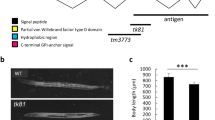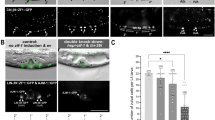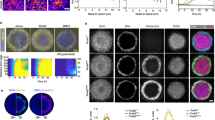Abstract
During Caenorhabditis elegans vulval induction the anchor cell of the gonad specifies a spatial pattern of three cell types among a set of six multipotent epidermal cells, the vulval precursor cells (VPCs)1–4. Previous studies suggested that the anchor cell produces a graded inductive signal which can directly stimulate VPCs away from a ground state (type 3) to become type 1 or type 2 depending on their distance from the anchor cell4. Here, we investigate the interactions among VPCs in a mutant, lin-15, in which VPC fates are rendered partially independent of the inductive signal5,6, and show that type 1 cells actively inhibit adjacent cells from also becoming type 1 cells. The fate of each VPC therefore depends on the combined action of two intercellular signals: a graded inductive signal from the anchor cell, and a lateral inhibitory signal from at least some of its neighbours. Pattern formation among the VPCs lin-15 mutant is analogous to the establishment of the pattern of neuroblasts and dermatoblasts during early insect neurogenesis7,8, suggesting that the similarities in inferred molecular structure of the lin-12 and Notch gene products, which are involved in these two instances of pattern formation9–12, might extend to similarities in function.
This is a preview of subscription content, access via your institution
Access options
Subscribe to this journal
Receive 51 print issues and online access
$199.00 per year
only $3.90 per issue
Buy this article
- Purchase on Springer Link
- Instant access to full article PDF
Prices may be subject to local taxes which are calculated during checkout
Similar content being viewed by others
References
Sulston, J. & Horvitz, H. R. Devl Biol. 56, 110–156 (1977).
Sulston, J. E. & White, J. G. Devl Biol. 78, 577–597 (1980).
Kimble, J. Devl Biol. 87, 286–300 (1981).
Sternberg, P. W. & Horvitz, H. R. Cell 44, 761–772 (1986).
Ferguson, E. & Horvitz, H. R. Genetics 110, 17–72 (1985).
Ferguson, E., Sternberg, P. W. & Horvitz, H. R. Nature 326, 259–267 (1987).
Doe, C. Q. & Goodman, C. S. Devl Biol. 111, 206–219 (1985).
Technau, G. M. & Campos-Ortega, J. A. Wilhelm Roux Arch devl Biol. 195, 445–454 (1986).
Greenwald, I. S. Cell 43, 583–590 (1985).
Wharton, K. A., Johansen, K. M., Xu, T. & Artavanis-Tsakonas, S. Cell 43, 567–581 (1985).
Kidd, S., Kelley, M. R. & Young, M. W. Molec. cell Biol. 6, 3094–3108 (1986).
Yochem, J., Weston, K. & Greenwald, I. S. Nature (in this issue).
Sulston, J. E., Schierenberg, E., White, J. G. & Thomson, J. N. Devl Biol. 100, 64–119 (1983).
Wigglesworth, V. B. J. exp. Biol. 17, 180–200 (1940).
Wilcox, M., Mitchison, G. J. & Smith, G. R. J. cell Sci. 12, 707–723 (1973).
Greenwald, I. S., Sternberg, P. W. & Horvitz, H. R. Cell 34, 435–444 (1983).
Campos-Ortega, J. A. Trends Neurosci. 8, 245–250 (1985).
Brenner, S. Genetics 77, 71–94) (1974).
Avery, L. & Horvitz, H. R. Cell 51, 1071–1078 (1987).
Author information
Authors and Affiliations
Rights and permissions
About this article
Cite this article
Sternberg, P. Lateral inhibition during vulval induction in Caenorhabditis elegans. Nature 335, 551–554 (1988). https://doi.org/10.1038/335551a0
Received:
Accepted:
Issue Date:
DOI: https://doi.org/10.1038/335551a0
This article is cited by
-
Coordinating cardiomyocyte interactions to direct ventricular chamber morphogenesis
Nature (2016)
-
Chromatin regulation and sumoylation in the inhibition of Ras-induced vulval development in Caenorhabditis elegans
The EMBO Journal (2005)
-
Sequential signalling during Caenorhabditis elegans vulval induction
Nature (1995)
-
Facilitation of lin-12-mediated signalling by sel-12, a Caenorhabditis elegans S182 Alzheimer's disease gene
Nature (1995)
-
In search of new mutants in cell-signaling systems of the nematodeCaenorhabditis elegans
Genetica (1993)
Comments
By submitting a comment you agree to abide by our Terms and Community Guidelines. If you find something abusive or that does not comply with our terms or guidelines please flag it as inappropriate.



